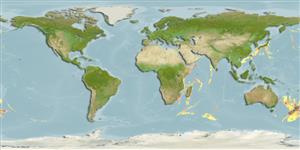>
Ophidiiformes (Cusk eels) >
Bythitidae (Livebearing brotulas)
Etymology: Barathronus: Greek, barathron = abyss + ending -ites, that lives there; the Barathron was a deep pit in Athens where criminals were thrown; 1849 +Greek, onos = hake.
Environment: milieu / climate zone / depth range / distribution range
Οικολογία
Θαλασσινό(ά) βαθύβιο(ς); εύρος βάθους 386 - 1525 m (Ref. 34024). Deep-water
Indo-West Pacific: off South Africa, Madagascar and Mozambique to Japan, the Philippines and Australia.
Μέγεθος / Βάρος / Age
Maturity: Lm ? range ? - ? cm
Max length : 18.0 cm TL αρσενικό/απροσδιόριστο; (Ref. 6611)
Short description
Κλείδες προσδιορισμού | Μορφολογία | Μορφομετρία
Μαλακές ραχιαίες ακτίνες (συνολικά) : 75 - 83; Μαλακές εδρικές ακτίνες: 55 - 66; Σπόνδυλοι: 74 - 79. This species is distinguished by the following characters: when preserved, distinct, dark brown pigmentation dorsally between head and dorsal fin and on the sides of the light brown body; fresh specimens when newly caught with dark blue-like pigmentation on the peritoneum and body faintly reddish; D 75-83, A 55-66; vertebrae 74-79; vomer with up to four fangs, dentary with up to five fangs; penis length up to 10% SL, proximally covered by a large dorsal clasper and a smaller ventral clasper protected ventrally by a well-developed fleshy hood; eyes not externally visible in specimens longer than about 14.0 cm SL, while eyes of smaller specimens appear as a narrow, dark ring surrounding lighter tissue (Ref. 128809).
Rare species (Ref. 34024). Viviparous. Relatively often caught by commercial trawlers for it also occurs on the upper continental slope (Ref. 128809).
Life cycle and mating behavior
Γεννητική Ωρίμανση | Αναπαραγωγή | Γεννοβολία | Αβγά | Γονιμότητα | Προνύμφες
Nielsen, J.G., J.J. Pogonoski and S.A. Appleyard, 2019. Aphyonid-clade species of Australia (Teleostei, Bythitidae) with four species new to Australian waters and a new species of Barathronus. Zootaxa 4564(2):554-572. (Ref. 128809)
IUCN Red List Status (Ref. 130435: Version 2024-2)
Threat to humans
Harmless
Human uses
αλιεία: χωρίς ενδιαφέρον
Εργαλεία
Special reports
Download XML
Διαδικτυακές πηγές
Estimates based on models
Preferred temperature (Ref.
123201): 2.1 - 9.6, mean 6.8 °C (based on 265 cells).
Phylogenetic diversity index (Ref.
82804): PD
50 = 0.5005 [Uniqueness, from 0.5 = low to 2.0 = high].
Bayesian length-weight: a=0.00447 (0.00172 - 0.01163), b=3.10 (2.87 - 3.33), in cm total length, based on LWR estimates for this (Sub)family-body shape (Ref.
93245).
Τροφικό Επίπεδο (Ref.
69278): 3.4 ±0.5 se; based on size and trophs of closest relatives
Ελαστικότητα (Ref.
120179): Υψηλό, ελάχιστος χρόνος για διπλασιασμό πληθυσμού < 15 μήνες (Preliminary K or Fecundity.).
Fishing Vulnerability (Ref.
59153): Low vulnerability (10 of 100).
Nutrients (Ref.
124155): Calcium = 47.3 [26.0, 106.9] mg/100g; Iron = 0.502 [0.248, 1.006] mg/100g; Protein = 15.9 [13.5, 18.3] %; Omega3 = 0.386 [0.182, 0.815] g/100g; Selenium = 19 [7, 46] μg/100g; VitaminA = 17.7 [3.6, 83.0] μg/100g; Zinc = 0.517 [0.337, 0.789] mg/100g (wet weight);
